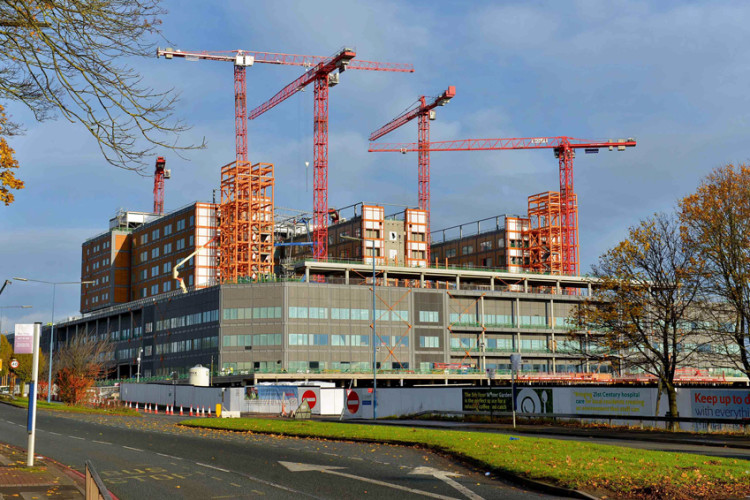The collapse of Britain’s second-largest construction firm, Carillion, is symptomatic of a larger problem. Globally, construction performs poorly compared to other sectors. And the underlying cause of the sector’s underperformance is that construction lives in the 19th century.
Across any measure of process or technological advancement – be it software tools, big data, modularisation, digitalisation, or the use of lean concepts – construction ranks among the worst performing sectors and remains deeply fragmented. To meet the demands of the 21st century, construction requires a technology revolution.
Construction remains slow, costly and local: it is the only sector of the economy where labour productivity has in fact declined in the past thirty years. And these problems compound as the scale of a project grows.
Research at the Saïd Business School, University of Oxford, has shown that the problems of cost and time overruns, benefit shortfalls, environmental damage, and negative social impacts plague the delivery of the biggest construction projects in a systematic fashion. Such evidence is an indictment of the construction ‘megaproject’ tendency.
Despite its prominent position in the British construction industry, Carillion operated with antiquated technological systems. Consider the Midland Metropolitan Hospital in Smethwick, one of Carillion’s largest live projects, whose losses contributed to the company’s demise: on 24th May 2017, the opening of the hospital was delayed, the proximate cause reportedly being issues with the mechanical and electrical design.
The root cause, however, was a poorly integrated building information model with large discrepancies. Instead of a slick flow between design and production – now a common feature of manufacturing – the construction job evolved into a manual patchwork of incremental fixes which added cost and time.
Business wisdom suggests that what doesn’t get measured doesn’t get managed, and the Midland Metropolitan Hospital project lacked the big data and advanced analytics, now integral to business success, to measure progress accurately.
Unlike the highly automated manufacturing of automobiles or computer microprocessors, construction remains a handcrafted, artisanal industry. Offsite manufacturing of building components to obtain the benefits of standardisation is gaining acceptance but its use remains undisciplined.
For the Midland Metropolitan Hospital, the unitised curtain walling for the project was assembled offsite in Portugal. But it was hand built. It combined the disadvantages of offsite assembly, namely transport costs, with the variance and rework costs of manual building.
Although the construction sector’s problems are towering, they are not insurmountable. Global shipping was a similarly manual and bespoke industry in the 1950s when cargo was shipped loose – freight arrived in receptacles of all shapes and sizes: cardboard cartons, sacks and open crates.
Thanks to the advent of containers, shipping a tonne of cargo is 99% faster and over 90% cheaper today than it was in the 1950s.

Containerised shipping became faster, better and cheaper by achieving three transformations: bespoke became standardised and modularised; analogue became digital; and manual became automatic. As a consequence of these three transformations, a fragmented shipping industry became a global platform.
Similar order-of-magnitude leaps have been observed for both automobile manufacturing and computing. The tech revolution in the construction sector has the same potential.
If the benefits of construction are to flow to 7.6 billion people, the industry must modularise.
The most salient element of construction digitisation is to convert 2D analog design information (e.g. architects’ drawings) into digital models. Using high-fidelity building information modelling (BIM) tools, ‘starchitect’ Frank Gehry is able to deliver complex and beautiful wonders on time and on budget.
The use of robots nearly doubled labour productivity in the automobile industry between 1990-2000. Similarly, Amazon’s competence in using automated processes – e.g. to reconcile financial accounts – helped the company scale it revenues sevenfold between 2008-2016. For the construction sector to enjoy similar benefits, its processes must become similarly automated.
Carillion is a powerful reminder that project failures precipitate corporate failures. Poor construction outcomes suggest that we should brace for more insolvenices. At the same time, experiments in modular, digital and automated construction are taking hold. For example: Google’s modular server farms or its new headquarters in California being built using robot-crane hybrids (crabots); Bechtel’s innovations in offshore oil platforms; Arcadis’ 100% BIM pledge; Arup’s big data initiative and WinSin Construction’s 3D-printed apartment building.
The construction sector must now turn to scaling these radical technologies.
Below: Dr Atif Ansar is a Fellow of Keble College, University of Oxford, and programme director of the MSc in Major Programme Management at Oxford’s Saïd Business School. He has worked with HM Treasury, the World Bank and several Fortune 500 companies.

This article was first published in the March 2018 issue of The Construction Index magazine, which you can read for free at http://epublishing.theconstructionindex.co.uk/magazine/march2018/
UK readers can have their own copy of the magazine, in real paper, posted through their letterbox each month by taking out an annual subscription for just £50 a year. See www.theconstructionindex.co.uk/magazine for details.
Got a story? Email news@theconstructionindex.co.uk


.gif)
